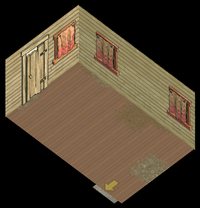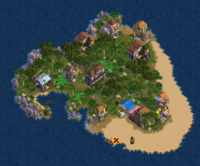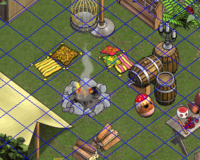Scene

A scene is a virtual space in the game. Pirates can interact with some scenes; for instance they can walk around on an island, and place furniture in a building belonging to them. All scenes comprise a number of 2D tiles.
A scene can be:
- A room in a building or ship.
- The outdoors of an island.
- The series of decks on a ship (all decks are part of one scene).
Pirates, NPCs and pets may move around in most scenes. Pirates can also interact with other pirates, NPCs and pets within the scene in real time. Additionally, pirates may interact with some elements of scenes such as the furniture found in inns and duty stations aboard ships.
Scenes are linked by yellow portal arrows on the ground. Many scenes collected together form locations such as buildings and ships. The outdoors of an island is one large scene.
Contents
Parts of a scene
All scenes comprise four basic parts:
- A base layer is the floor of the scene, and displays static textures like wood panelling or mud on floor tiles. All but a few textures can be traversed by pirates. The exceptions are known to include lava, bog, water and fissures. Additionally, the tiles immediately adjacent to non-traversible tiles cannot be traversed either. The base layer is flat, although the illusion of elevation can still be produced by carefully selecting floor tile textures and objects. (See Yax Mutal island for a very good example of this). Some floor tiles will contain yellow portal arrows, in addition to a texture, which allow pirates to move between scenes. No objects can be placed on these tiles.
- An object layer displays static 3D objects which populate the scene, for example trees, rocks, buildings and furniture. No tiles containing objects can be traversed by pirates. Of all objects, only buildings and furniture can be placed from within the game. Objects on islands may also be known as charm, and can only be adjusted when the game is offline for a reboot.
- A dynamic object layer displays the dynamic 3D elements of the scene. Unlike objects, the elements in this layer can walk around in scenes (and possibly move between them). Elements in this layer include pirates, pets and NPCs.
- A sprite layer allows 2D elements and icons to be displayed in scenes. These include speech bubbles, text labels (on some furniture items, and also the names of pirates, pets and NPCs), activity icons above pirates and NPCs, and the mute symbol.
Types of scene
There appear to be two main types of scene within the game. It is possible to distinguish between the two according to how they handle the /speak chat command:
- A room is a series of floor tiles and is always bounded by an empty black expanse. An example is a room in a house. This type of scene typically includes two walls, on the farthest two sides towards the top of the game window. The walls can sometimes be painted, and some furniture items may be placed on flat areas of the wall. Note that gardens and lobbies of houses (such as villas are still rooms, although outdoor furniture may be placed in them. Pirates in these scenes are able to communicate with one another using /speak without the need to join a chat circle.
- An outside scene is not bordered by the walls seen in rooms. The two examples of an outside scene are islands and the decks of a ship. Typically these scenes have no visible walls. However, on some ships, banners can be hung along one side of the hull. Pirates in these scenes cannot communicate with one other using /speak unless they are part of a chat circle.
Interacting
In all scenes, pirates can interact with one another by sending trade and challenge requests, as well as hearty and crew invitations. Additionally, pirates can interact with some placed objects by clicking on them.
Communicating
In rooms, pirates can communicate using the /speak command. In outside scenes, pirates must be part of the same chat circle to speak to each other (or they must use other chat channels, for example tells or vessel chat).
Moving around
Pirates, pets and NPCs can all move around within scenes. However, without player intervention, it is thought that pets and NPCs cannot move between scenes. The known exceptions to this rule are NPCs found on limited edition ships such as the Phantom class sloop, which may move within scenes and between scenes on the ship. Pirates may move between scenes using the yellow portal arrows on the ground. There may be a small delay between clicking the arrow and entering the scene, as the new scene must be loaded.
Pirates, pets and NPCs cannot traverse tiles containing objects such as furniture, charm or buildings, nor can they traverse tiles containing certain types of terrain such as lava or water. However, in many scenes, such as rooms or outdoors, a path can be found to move between any two unoccupied squares. If this is possible, the pirate, pet or NPC will walk there; if not, pirates will receive a message stating "Avast! I can't find a way to walk there.". To access different decks of a ship, use the yellow portal arrows by the steps.
Exploring the pirate world
To move around, simply choose somewhere to go and click. If there's a path, and there's room to stand, then your pirate will set off towards the destination at a leisurely pirate pace. Similarly, to inspect something, simply click on it. For instance, clicking on a pirate will bring up the radial menu with options to view their info page or challenge them to a puzzle, among others. To hop between scenes, use the yellow arrows on the ground.
Some interfaces, like the dock, allow pirates to hop between islands. Pirates can also invite each other to another scene using /invite. Use /job to whisk pirates aboard a ship. Finally, to return to your pirate home, click to home on the Ye panel.
To move your view of the scene around, right click somewhere within the scene. This pans the view to center on where you clicked, if possible, but it will not let your pirate to go out of sight. The view will automatically center on your pirate's destination if the pirate has recently moved. Should your pirate's destination take him or her off your screen, fear not! The view will automatically center on the pirate the moment he or she dissappears from the current view.
Pathfinding
Pirates, pets, and NPPs follow simple zig-zag paths when walking, and cannot move diagonally; each tile in a path must be adjacent to the one which preceeded it. Additionally, only the tiles currently in view of the pirate at the time are considered when planning the path. Thus, journeys across large or complex scenes (for example, outdoors) must be made slowly and in small stages, scrolling to reveal the next segment of a path at each stage.
If the destination is a portal arrow, and no valid path can be found, a pirate will "warp" - travel immediately - to that location shortly before exiting the scene. This is also true for interactive objects which have been clicked on, unless there is no room around the object - in which case the pirate will interact with it but not move. Pets which are following pirates will also do this.
Editing scenes
Players can edit many scenes in a number of different ways. For example, building owners and ship deed-holders may arrange furniture and paint some scenes. They may also set pets to roam in some scenes.
Island governors may add pets to an island, and may place buildings.
Notes
- A pirate will see his or her hearties' names underlined in scenes, and greenies' names will appear green. Additionally, greeters' names appear pink to greenies and other greeters.
- Items in scenes may be labelled with a text bubble when entering the scene; when a pirate first moves, this text will disappear. However, hovering the mouse pointer over the item will show the bubble. To see all text bubbles, press the "alt" key. To reset the text bubbles, exit and re-enter the scene.
- All pirates in a scene receive disconnection notices about other pirates within the same scene.
- Some parlor game tables and tournaments may restrict entry to local players only. If this is selected, the listing for that particular table or tournament is only visible within the local scene. Pirates outside of the scene the table or tournament was created in can not see nor join the table or tournament.
- Should a pirate on a ship change scenes between the time that a grapple is thrown and entry into the swordfight or rumble, then they may be left out of the fight.
Historical notes
- Before a release of unknown date, it was possible to place furniture over portal arrows in scenes. This was commonly used on pillages aboard large ships. While the ship would be waiting for boarders, parlor games tables would be permanently placed in the ship's cabin to keep jobbers entertained. When sailing, the owner would place an inexpensive furniture item (such as a Slatted crate) on top of the portal arrow to prevent access to the tables. This prevented the expensive games tables from crumbling into dust due to repeated placement, and also helped to ensure that jobbers focused on their duties.
See also
- Yohoho Tools is the Puzzle Pirates island scene editor.

